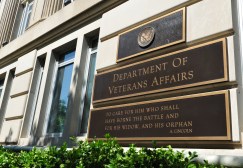Certified VA-DOD interoperability still lacking, lawmakers say

The Department of Veterans Affairs claims it’s made it easier than ever to swap electronic health records with the Pentagon, but lawmakers say the underlying platform still lacks key capabilities — like the ability to provide images or things like analytics.
With the new “read only” Joint Legacy Viewer EHR exchange platform, the VA and the Defense Department already reached the level of interoperability required by the 2014 National Defense Authorization Act, VA CIO LaVerne Council testified before the Senate Appropriations Committee’s Subcommittee on Military Construction, Veterans Affairs, and Related Agencies Wednesday. As of July 7, she said in prepared testimony, “JLV had more than 198,000 authorized users in VA and DOD together, including 158,159 authorized VA users.”
Even so, senators on the committee argued the two departments hadn’t yet met true interoperability because those exchanges still lack a number of capabilities veterans would expect to see after leaving active duty.
“It does not provide the X-ray data of patient,” Chairman Sen. Mark Kirk, R-Ill., said of JLV, which he referred to as a “Band-Aid” solution. “So we would say now, ‘Welcome to the VA, we have no X-ray data on you from all the X-rays the Navy, the Army, the Air Force did for you.’”
CT scans are also not included in the exchange of EHRs between the two departments, he said.
“I think most members of this committee would say that is not interoperable,” Kirk said.
JLV is only part of the VA’s larger move to a more modern health IT environment and away from its decades-old Veterans Health Information Systems and Technology Architecture, known as VistA. More recently, Council announced, VA will look to depart from the VistA platform in coming years in favor of a more modern, centralized and open source-based Digital Health Platform project.
[Read more: VA teases plans for new ‘state-of-the-art’ digital health platform]
For now, the VA and DOD only share narrative reports on that type of imagery missing from JLV, which the VA officials said can be just as important as the imagery itself in helping to interpret it.
“The data we are exchanging now is all of the health record data, which includes 25 domains of standardized data where standards exist,” said David Waltman, VistA Evolution program executive and senior adviser to the undersecretary for health at the Veterans Health Administration. “So that includes progress nodes, lab reports … it includes the reports from all of those imaging studies. And as we know, the size of the data for the studies themselves is exponentially larger.”
VA is in the process for delivering the image-viewing component for JLV, which it plans to release in September, Council said.
Even then, Kirk argued, JLV won’t have the advanced capabilities like analytics needed to ensure the care of veterans that is found in many commercial health IT solutions. He frequently mentioned Cerner, the health care company helping to lead DOD’s development of its Defense Healthcare Management System Modernization project, as an example of a provider that currently uses data to calculate, for example, suicide risk.
“JLV is 100 percent incapable of those analytics,” Waltman agreed.
“We need an integrated capability of all of the clinical data, the process management for managing clinical workflows, integrated with analytics that can use algorithms … that can predict, based on the information in the record and pathways and courses of action available, what interventions should be taken and what the processes and care pathways should be,” he said.
Agreeing to that as a more accurate definition of complete interoperability, the subcommittee pushed Waltman for a timeline when that might happen.
“The middle of calendar year 2018,” he responded.
Given that, it may be necessary to revise the definition of interoperability between VA and DOD — because, Kirk said, the current one that doesn’t cut it.
“When we got to the heart of this hearing, you certified that you were interoperable based on the JLV’s existence, and we now know that the JLV does not have X-rays or CT scans — and that is interoperable from your viewpoint,” he said in closing. “I would say to expect some further definition from this committee on that point. We need to move forward on this point to make sure that there is no net burden on the soldier or sailor when they come out of the service, that we 100 percent transfer their data to VA.”






